Knitting is one of the most popular types of needlework today and more and more people want to master it. Knitted items attract lovers of exclusive clothing and world fashion designers.
It is better to learn knitting with the simplest patterns, gradually moving on to more complex and interesting techniques. There are a lot of patterns and methods of knitting with descriptions and patterns, and they are often limited only by the flight of fantasy.
Types of knitting patterns
Knitting patterns with descriptions and diagrams can be divided into simple, more complex and for experienced knitters. Having mastered various techniques and the ability to knit various patterns, when knitting they can be combined, adding more and more originality and individuality to the product.
| Types of patterns | Description |
| Simple patterns | These are patterns consisting of simple loops - front and back, which include the so-called stocking stitch or front surface, garter stitch, confusion, strokes, back strip, holes, rice. Such patterns are mastered by beginner knitters first of all. |
| Rubber bands | Elastic bands are also knitted with simple loops. This pattern is well known and is mostly used in trim elements: cuffs on sleeves and at the bottom of products, when knitting high stand-up collars. There are a lot of elastic bands and, despite the apparent simplicity of knitting, you can knit beautiful hats, scarves, sweaters with it. This type of knitting is very elastic, stretches well, does not lose shape, and products knitted with elastic fit exactly on the figure. It should be remembered that elastic bands cannot be ironed or treated with steam - they can stretch out and lose shape. |
| Relief patterns
| This pattern is knitted by alternating convex and concave loops, thanks to which relief and three-dimensionality are formed on the fabric, making the design clear and expressive.
Relief patterns are knitted using not only simple ones, but also more complex ones - inclined, crossed, crossed, removed and extended loops. A product with such a pattern should be ironed and steamed: it is enough to moisten and dry in the fresh air. Otherwise, the relief of the pattern can be damaged. With their help, patterns such as large honeycombs, shells, pins and inclined ones are obtained. |
| Fine knit patterns or fabric patterns
| The patterns knitted with this type are quite dense and resemble fabric in structure. They are well suited for knitting children's products, dresses, suits, coats, and can also be used in trim elements.
Small knit patterns include star, flax, and double moss patterns. To create such patterns, many types of loops are used - purl, dropped, inclined, front, crossed. |
| Checks, diamonds, braid
| The name of these types of patterns speaks for itself - these are all kinds of diamonds, squares, simple and intricate weaves.
The diamond pattern looks very beautiful on openwork blouses, sweaters, skirts, dresses, and children's items. Adding knitting elements in the form of cones and stars makes the pattern even more interesting. And woven diamonds are an ideal pattern for more voluminous items: sweaters, cardigans, or snoods. Products knitted with a braid pattern are quite dense and are suitable for hats, mittens and even socks. The check pattern also has a dense texture and, depending on the knitting technique, can be double-sided. This pattern is used to knit blankets, scarves, and sweaters. |
| Openwork patterns
| The main element of this type of pattern is holes of various shapes, formed with the help of loops with a yarn over. They are what give the fabric an openwork lightness and airiness. Judging by the appearance of the product, it may seem that the openwork patterns are crocheted, but they are easily knitted on two knitting needles.
It is best to choose thin yarn for these patterns - it will better emphasize the light lace shapes of the product. With their help, you can learn to knit beautiful summer clothes, as well as thin and light warm blouses and dresses. |
| Multicolor patterns
| These patterns are also called false jacquards or simply lazy. They require a lot of knitting experience from the craftswoman, and take much less time, compared to classic jacquard patterns. But, given that the pattern is multi-colored, there are certain subtleties of its knitting, which depend on the chosen pattern.
For example, when knitting with an original technique using two-color yarn, a double-sided pattern is obtained, which means that the product is more interesting and can be used from either side. In general, multi-colored patterns can be quite intricate and they produce very interesting and beautiful products. |
| Braids, plaits, arans
| These are some of the most popular patterns and are an essential attribute of the so-called Aran knitting or Aran, which just implies all sorts of patterns in the form of braids, plaits, as well as braids and other various interlacings. This knitting style comes from the Irish island of Aran, where local women knitted warm sweaters for fishermen. Products from such patterns are dense, durable and very warm. Plaits and braids are used when knitting cardigans (from thin yarn), sweaters. They are very popular now when knitting hats, scarves, mittens. Products are obtained with beautiful interlacing and original.
When knitting braids and cables, mainly inclined loops are used, which are changed in places during work, and also a third additional knitting needle is used. |
| Jacquard patterns
| The patterns belong to the multi-color group. They are characterized by frequent changes in yarn color and differ from false jacquards in that the threads are pulled (changed) from the back side of the product. An important nuance - the loose threads on the back side must be pulled with optimal tension. A tightly pulled thread will tighten and wrinkle the fabric and distort the pattern. With a loose tension, the threads on the back side will sag, and the product will have uneven loops and be loose, and again the pattern will be distorted.
The basis of jacquard knitting is stocking stitch. But! Knitting this pattern requires diligence and a lot of experience from the craftswoman. Jacquard patterns often have an ethnic theme and can most often be found on sweaters (snowflakes, deer) and mittens. |
Loop symbols and methods for making them for beginners
Knitting patterns with descriptions and diagrams are easy to learn to read. The description always provides step-by-step instructions for performing the work, and the diagrams show the order and symbol of the knitted loop. There are quite a lot of types of loops and ways to perform them. You need to know them to be able to read the diagrams.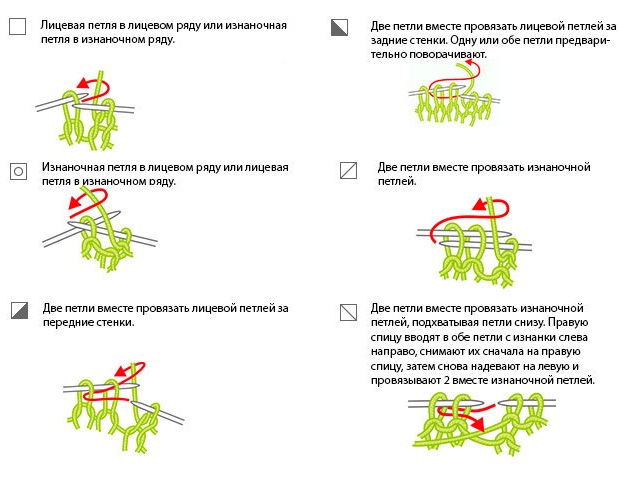
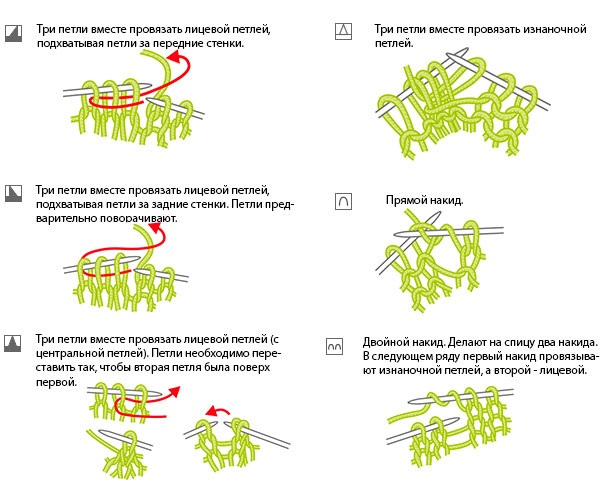
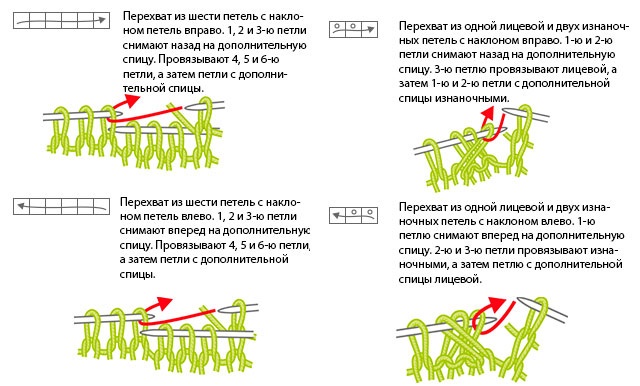
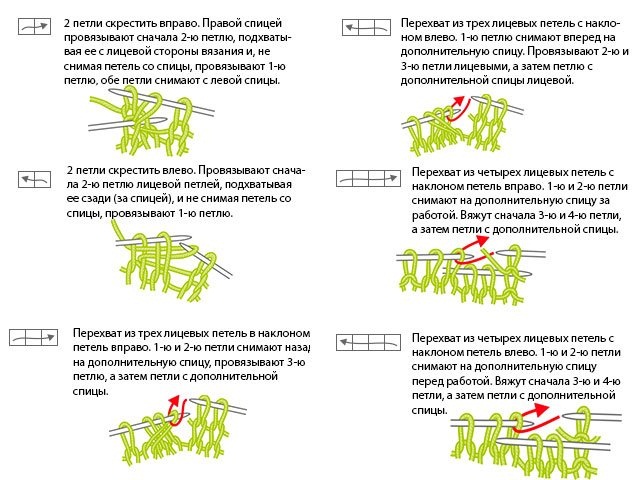
But in different literature, the designations of loops may be different. For example, in one magazine, the front loop is designated by an empty square, and in another - by a square with a vertical line inside. But, together with the pattern, there is often a decoding of the conventional designations of the loops, so it is quite easy to navigate the scheme. The main thing is to master the technique of knitting these loops.
Knitting Pattern Techniques
Knitting patterns, with descriptions and diagrams, can be made in various techniques, intended, to a greater extent, for craftswomen who already have a certain level of knowledge and knitting skills. But if regular knitting has already been mastered, you can move on to learning new and interesting techniques.
Patchwork
An entertaining technique for lovers of multi-colored products. Knitting from motifs or patchwork is popular in creating interior and decorative items (blankets, tablecloths, decorative pillows, carpets). As a rule, these products are large in size, which are almost impossible to knit manually on two knitting needles.
For this, small elements are knitted - motifs, which are then sewn together. They can be in the form of squares, circles, flowers, stars. And, of course, different colors are used when knitting them. The products turn out bright and original.
Knitting in the patchwork technique has one feature. If the product needs to be enlarged, for example, a blanket for a bed (the bed size has increased), then you can knit to it the number of motifs that are necessary to increase the size and sew them on. The same can be applied to clothing knitted in patchwork.
Knitting with needles enterlak
This knitting technique is still gaining popularity, but only among experienced needlewomen. It can be attributed to patchwork, but the peculiarity is that the product knitted using the enterlak technique is one-piece, despite the fact that it seems to be assembled from numerous diamonds.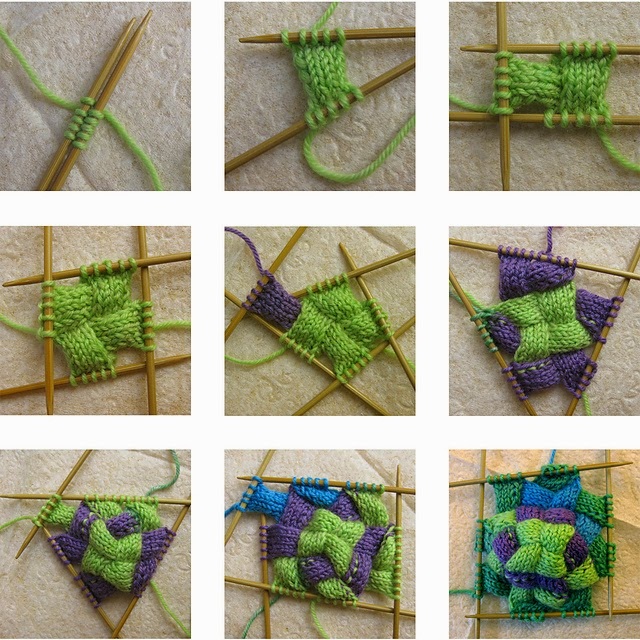
Before you start doing enterlak, you need to understand the nuances of this technique well, and then there will be no difficulties when knitting.
Enterlac knitting mechanism:
- For the sample, 30 loops are cast on.
- In the 1st row, remove the edge stitch, knit 1 purl, turn the work over;
- In the 2nd row, the edge and the next loop are knitted.
- Continue knitting, adding 1 loop in each row until there are 6 loops on the working needle, forming a triangle.
- Knit all subsequent free loops in the same way. As a result, you will get 5 triangles on 30 loops.
Next, cast on 6 stitches with a yarn over:
- 1 row – remove edge, 4 knit, connect 5th loop to the edge of the triangle, turn knitting;
- 2nd row – edge, 5 purl;
- Row 3 – remove edge, knit 4, connect 5th loop to the edge of the triangle, turn knitting;
- Row 4 – edge and 4 purl and so on.
To make the edges of the product even, the number of loops decreases or increases, in the middle of knitting this should not be done and then you will get quadrangular motifs, like in patchwork. With a similar continuation of knitting, you will get this fabric:
And this is what products made using this original technique will look like: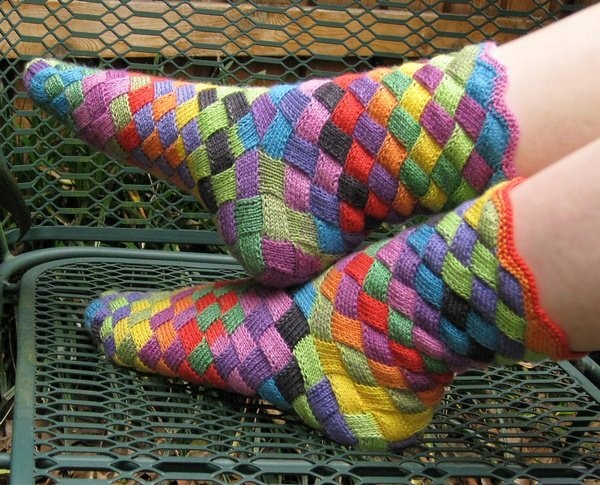
Jacquard patterns and intarsia technique
Both techniques are designed for knitting patterns using several flowers on clothes for adults and children, as well as in knitting jacquard patterns:
- Jacquard is a complex pattern made in the style of traditional Norwegian ornament, and intarsia is any free-style design, also made with two knitting needles during the knitting process.
- In jacquard, the idle thread is usually pulled through from the wrong side of the knitting. It does not interfere when changing clothes, since the distances between thread changes are short, it lies tightly on the product. But in intarsia this will not happen, since the patterns of this technique look like paintings. Many colors of yarn can be used, because you can knit a whole picture.
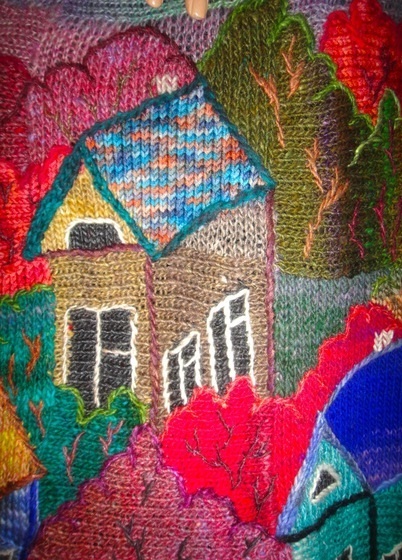
In this technique, thread is taken from different skeins for certain areas, at the boundaries of which the threads are crossed, creating the impression of stitching them together.
Swing technique
Otherwise, it is called the technique of rotary knitting or swing-knitting (from the English swing - swinging, oscillation). For the first time, swing as a new knitting technique became known in 1984 thanks to a book about non-standard knitting, published by an English professor of arts "Knitting in a Different Way".
In the finished product, the pattern of this technique can really be compared to music: such a smooth and moving pattern, in which movement and dynamics are felt. The products are truly non-standard and original.
An important advantage of swing knitting is that it can be done using leftover yarn, which craftswomen always have in abundance.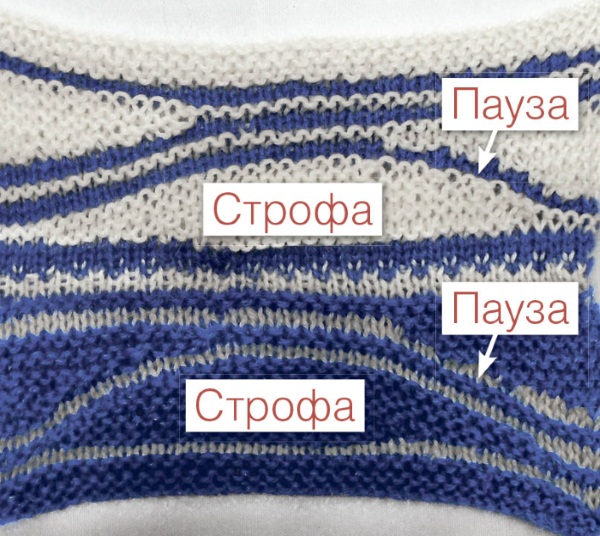
Rotary knitting consists of two elements:
- Stanzas - these are rows, the knitting of which is based on knitting with shortened rows. They are performed with garter stitch.
- Pauses – these are rows that go along the work and visually separate the stanzas from each other. They are made with stocking stitch.
The colors of the threads for pauses and stanzas should be different.
A knitter who wants to try her hand at the technique of rotary knitting needs to familiarize herself with the basics of composition and coloristics. For each work in this technique, it is necessary to prepare a knitting pattern - this will make the work process more convenient. And here, too, you cannot do without knitting a sample, otherwise you can incorrectly calculate the number of loops, stanzas and pauses.
Things knitted in the swing style are very beautiful: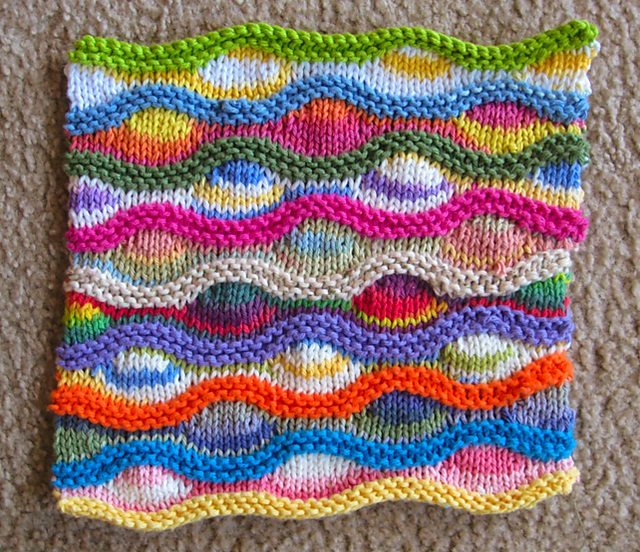
Irish Knitting and Openwork Techniques
These are always three-dimensional patterns made of all sorts of plaits, braids, diamonds and cones. As a rule, it is used to create warm clothes and accessories. Unlike multi-colored intarsia, Irish knitting is monochromatic (natural color) and in the classic version is always made of coarse sheep wool.
The openwork knitting technique is the direct opposite of Irish knitting, but they have a lot in common. Openwork knitting is always light, with many holes, made of thin woolen and cotton threads. Ideal for summer items, unlike warm sweaters in the Irish technique. But both of these techniques have the same knitting elements.
Technique of bias knitting and freeform
It is worth noting that these techniques are not easy and can only be done by professional knitters with many years of experience. Freeforms are based on the technique of skew knitting, with which you can knit elements of various shapes (polygons, circles, ovals).
In the freeform technique, as in patchwork, the fabric is assembled together, but this is labor-intensive. It is necessary to accurately calculate the dimensions and shapes so that when assembling into a finished model, the elements do not go beyond the edges of the pattern.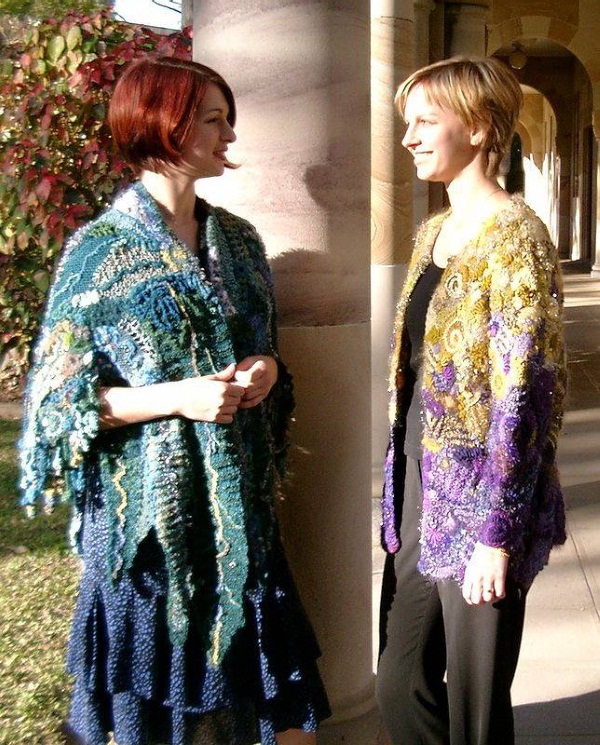
It is worth noting that products knitted with freeform look quite unique and are suitable, first of all, for lovers of extravagant clothing.
This technique also allows you to get rid of small skeins of yarn, which a knitter always has in large quantities. You can simply knit various fancy elements from the remains, and when there are enough of them, collect them into some unusual thing or accessory.
But all these knitting techniques are more suitable for advanced craftswomen, and beginners are best off starting their acquaintance with the world of knitting with simpler ones. Knitting patterns with descriptions and diagrams can be found in abundance in specialized literature (magazines and books on knitting and handicrafts) and on the Internet.
Stockinet
The main types include the so-called flat knitting or knitting on two needles (garter stitch, jersey). The technique is easy to perform, it is better to start learning knitting with it.
The pattern is knitted in an elementary way: the front rows alternate with the back rows. When knitting on circular needles, all rows are knitted with the front ones. Stocking stitch on both sides - back and front.
Garter stitch
This technique is also considered simple and is suitable for beginners. The fabric is thick and warm. Previously, garter stitch was used to knit scarves, hence the name, but now it can be found mostly in scarves and sweaters.
Description:
- 1 row – all stitches knit, turn;
- Row 2: knit all stitches, turn knitting, continue to the desired size.
The difference between garter stitch and stocking stitch is that in the former the fabric is knitted all the time with front loops, but due to their alternation with back loops it turns out to be double-sided. In stocking stitch one side is strictly front, the other is back.
Garter stitch in the round
Since in circular knitting one side will always be the front side, here you need to alternate rows of loops: front, back, front, etc.
Garter stitch pattern: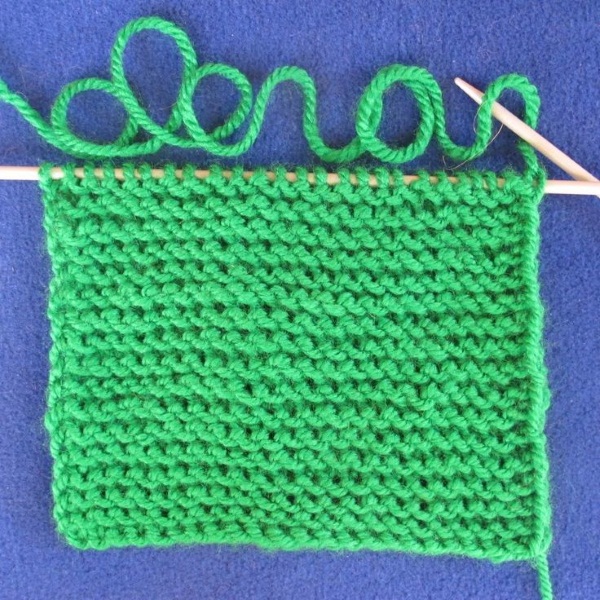
Technique-holes
The basis is stocking stitch, on which holes are knitted during the work. The pattern is not complicated, but mastering it will allow you to knit interesting products.
Knitting algorithm (set on needles - 2 edge + 12 sts + 2 sts to align the pattern):
- In the 1st row, knit a yarn over, then 2 pre-turned front loops behind the back walls, 10 front loops, knit another yarn over and 2 front loops behind the back walls;
- Rows that are multiples of 2, starting from the 2nd, are knitted purlwise;
- In odd rows (3, 5, 7, 9) all loops are knitted;
- In the 11th row, knit 6 persons. + yarn + 2 persons. behind the back walls, 4 persons., 2 persons.;
- Up to the 21st row knit the faces in odd and purl in even rows, from the 21st row the pattern starts repeating from the 1st row
Holes in the pattern and canvas:

Purl stripes
The knitting principle is based on alternating loops: purl loop on front surface: the first 6 rows are knitted as faces, and the 7th and 8th rows are knitted as purl. Then the pattern is repeated from the beginning.
Pattern in the diagram and nand on the canvas: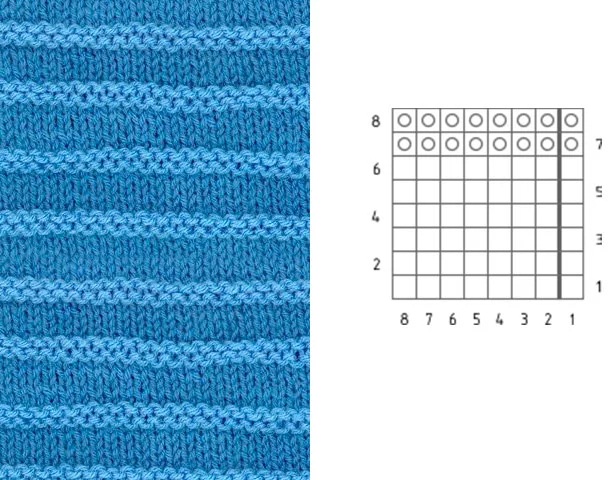
Strokes
This technique requires a certain amount of attention from the knitter, because if the knitting sequence is violated, the pattern may “float”.
Knitting order (2 edge stitches, 12 sts, 6 sts are cast on to the needles):
- From the 1st row onwards, 3rd, 7th and 9th rows are knitted;
- Row 2 and further even rows are knitted according to the pattern on the knitting needle;
- In the 5th row – remove edge, 6 purl, 6 knit, 6 purl, edge;
- In the 11th row - remove edge, 6 persons, 6 purl, 6 persons, edge;
- From row 13 – repeat the pattern starting from row 1.
Strokes according to the scheme and in the pattern:

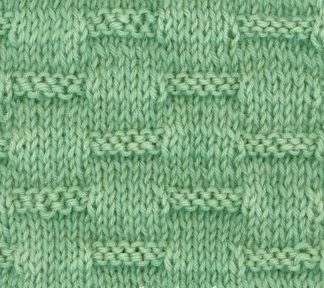
Rhombuses
The diamond patterns are simple, but look great on finished products. They are knitted quite easily with simple loops according to the pattern.
The knitting pattern for diamonds and the design itself look like this: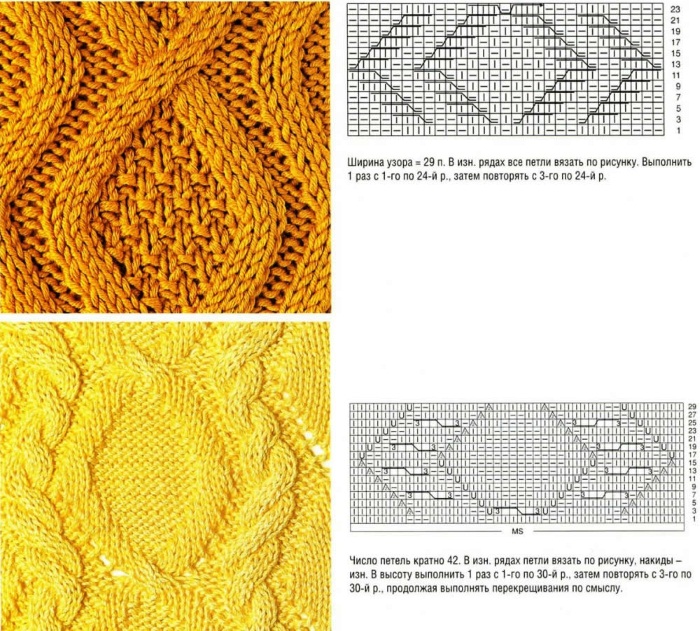
Rubber bands
There are many types of these patterns and they differ from each other both visually and in knitting technique.
Simple elastic 1x1
It consists of knitting simple loops one by one. At the end of the row, the knitting is turned over and the loops are knitted according to the pattern on the knitting needle.
Elastic band 1x1: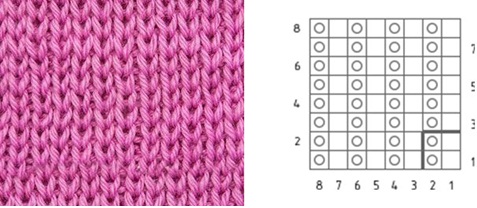
Simple elastic 3x2
The knitting principle is the same as in 1x1 elastic: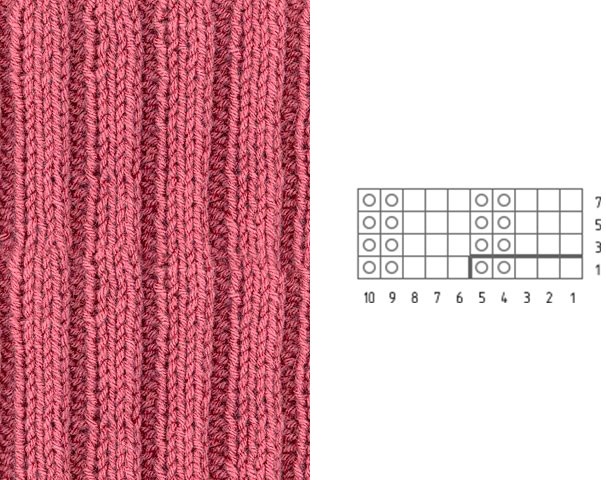
English elastic
It is more complicated in execution technique and can be most often seen in scarves. The fabric turns out loose and elastic.
Description:
- At the beginning of knitting, loops are cast on in a number that is a multiple of 3.
- In the 1st row, make a yarn over before the 1st loop, remove 1 loop, knit 2 loops together (picked up from the front);
- The 2nd row and the following ones are knitted in the same way as the first, but together a pair of loops and yarns are knitted.
Elastic band diagram: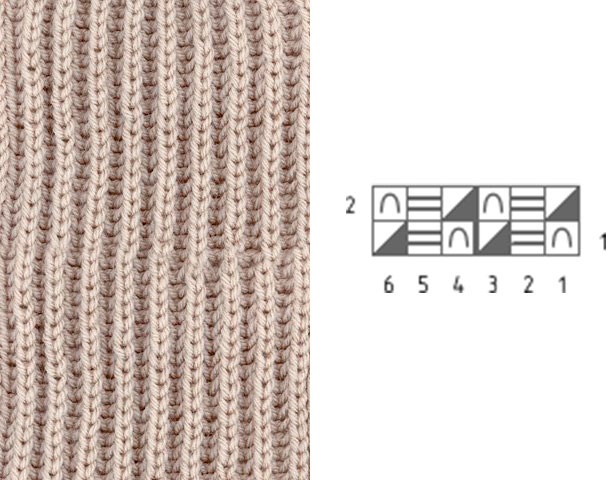
Convex elastic 2 x 2
Original elastic band for fashionable seamless snood scarves: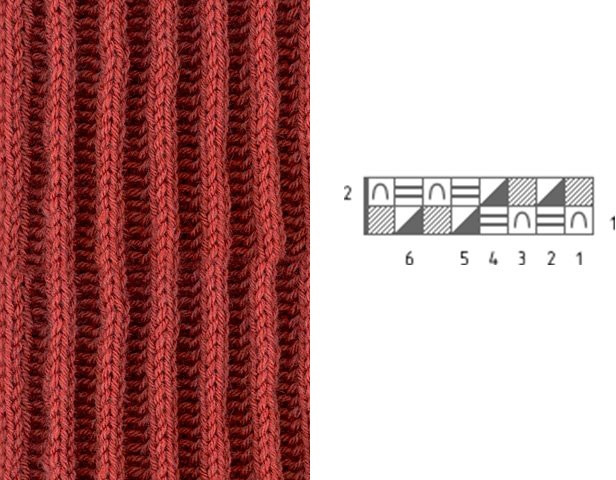
Other types of rubber bands
French elastic: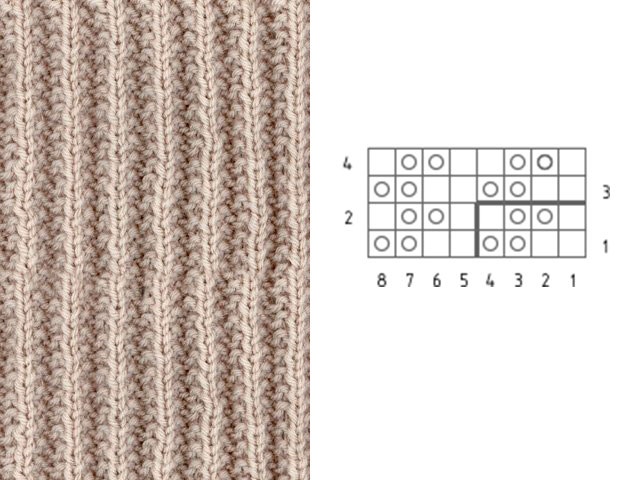
Pearl gum: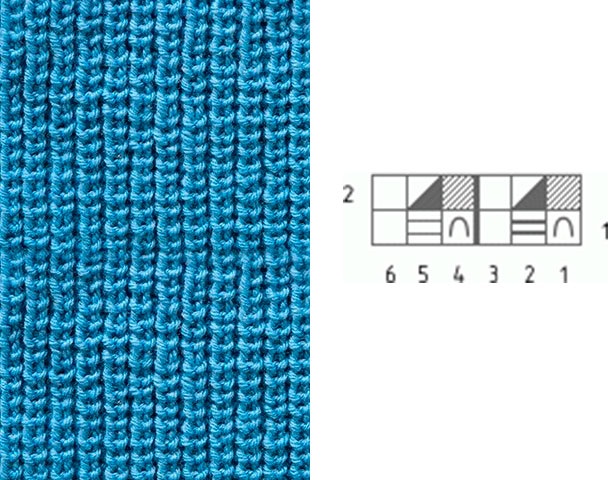
Scotch elastic:
Relief patterns
Reliefs are patterns that are complex to work with, as is the technique of knitting them.
Shells
Shells look equally beautiful when made from thin or thick yarn.
Large honeycombs
Another common but effective relief pattern. It is quick and easy to knit, and the fabric comes out soft and voluminous. The knitting is based on the technique of knitting patent loops - they are removed from the needles without knitting and with a yarn over.
The knitting pattern for large honeycombs and the design look like this: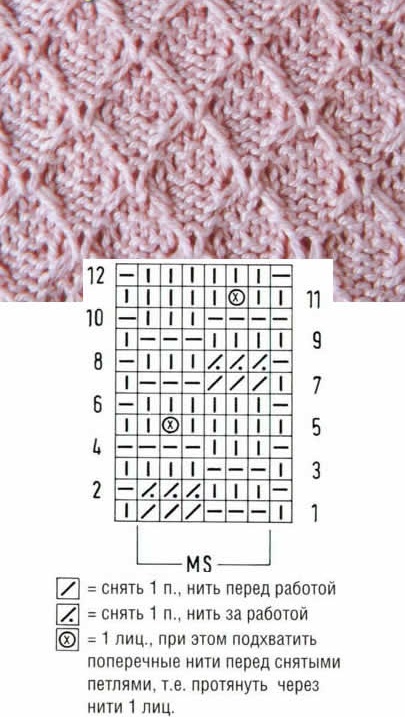
Fabric patterns
The fabric knitted in such a small technique looks like fabric, hence the name. Widely used in knitting such items as dresses, jackets, skirts, children's suits.
An example of a simple fabric pattern, its knitting pattern: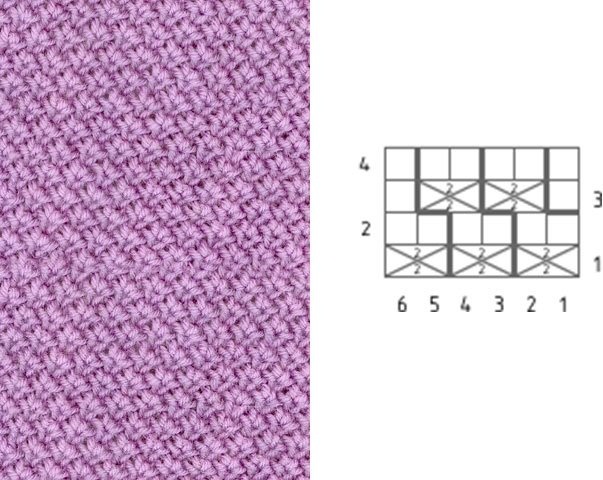
Fabric pattern using the loop pulling method: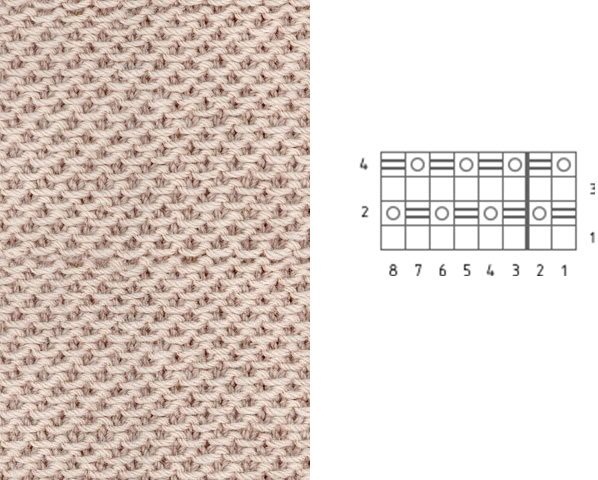
Small honeycomb pattern: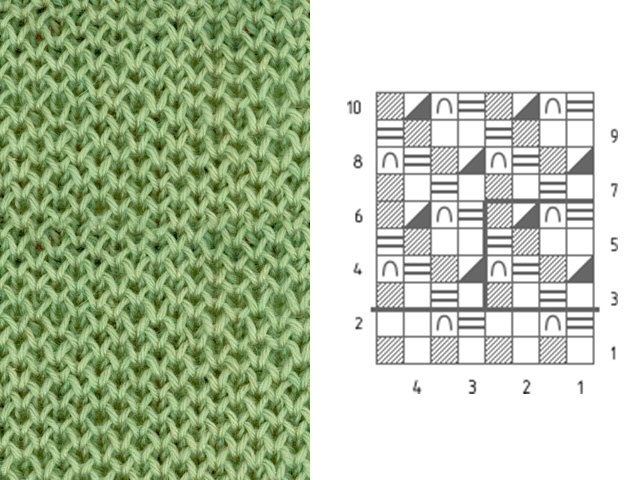
Fabric braid pattern: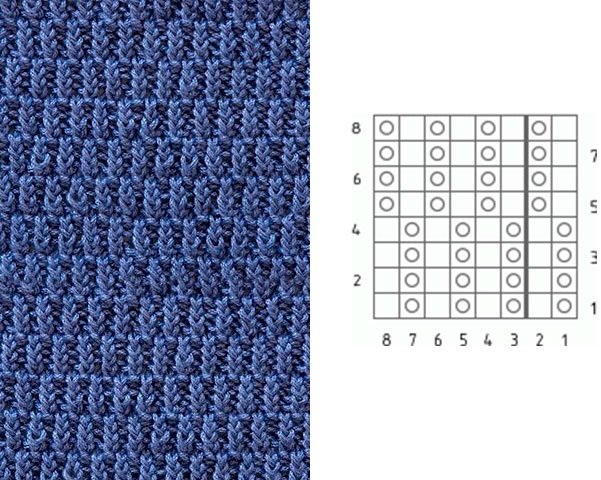
The peculiarity of this pattern is in the knitting of crossed front and back loops.
Patterns: check, diamonds, braid
The patterns are very popular among knitters - the items are original, and there are no complex elements in the knitting technique.
- Diamond pattern Beetles.
The pattern looks great on sweaters and is knitted using slanted stitches.
- Classic diamond and stripe pattern.
- Pattern "volume diamonds".
The beautiful interlacing of the braids in the form of diamonds is perfect for creating original hats, snoods, and sweaters.
- Network.
The braided pattern is ideal for blankets that turn out lush and beautiful.
And with the help of this pattern you can knit both a 2-color and a 3-color pattern:
- Checkered pattern.
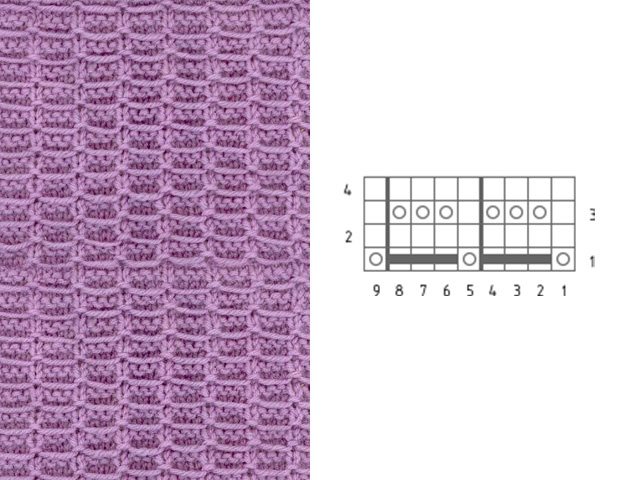
- Beautiful braid for mittens.
Openwork patterns
The technique of knitting openwork patterns is quite difficult, but it is worth it. Things knitted this way are light, elegant and original.
Knitting patterns with descriptions and diagrams of openwork patterns:
- Openwork knitting pattern.
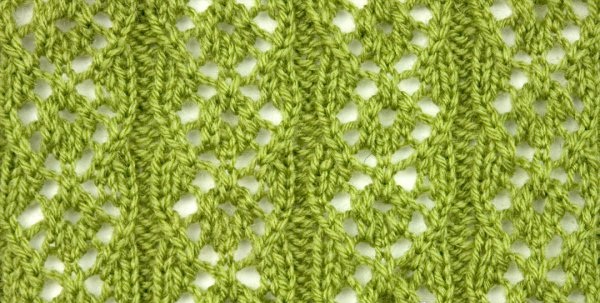

- Openwork pattern "diamonds".
The lace is reminiscent of crocheting and is perfect for summer items for both children and adults.
Beautiful braids, plaits, relief arans
All these patterns are united by the Irish knitting technique. Products made in these techniques are very warm, soft and original.
- Harnesses.
Such patterns are often used in the decoration of jumpers and dresses, adding originality and uniqueness to them.
- Braids.
This is another element of Aran, knitted with slanted loops. It looks very fresh as a decoration for sweaters, mittens, hats.
- Voluminous braid.
This pattern uses 2 techniques: cable knitting and pearl knitting.
- Eight.
- Lock.
Hand-made items have always been held in high esteem, and hand-knitted items are deservedly popular. With the help of patterns created using only two knitting needles, you can create clothes that are distinguished by their individuality and originality. And descriptions and patterns that can be found in the public domain can lead anyone into the world of knitting.
Article formatting: Vladimir the Great
Video about knitting patterns
Easy and beautiful knitting pattern:
